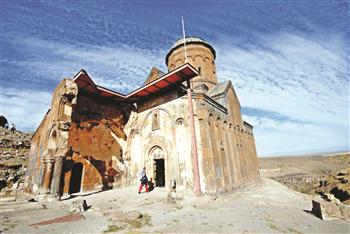 Ani, a ruined and uninhabited Armenian city situated in the eastern Turkish province of Kars on the Armenian frontier, will be the subject of new academic work to better present site to visitors
Ani, a ruined and uninhabited Armenian city situated in the eastern Turkish province of Kars on the Armenian frontier, will be the subject of new academic work to better present site to visitors
Archaeologists are planning renewed excavations next year in Ani, an ancient Armenian city in the eastern province of Kars that has long been regarded as one of Turkey’s most impressive tourist sites.
Academics from Pamukkale University in Denizli have applied to lead the excavation works and are currently conducting negotiations with the Culture and Tourism Ministry, according to Hakan Doğanay, the Kars culture and tourism director.
There are two application programs and three projects for the ruins that are right on the border with Armenia, he said, noting that the work was expected to finish by the end of 2013.
The work will involve creating a detailed map of the site, which was once the center of a powerful Armenian empire and possessed a population of between 100,000 and 200,000 over a millennium ago, making it one of the biggest cities in the world at the time.
Read also
“The workings that will be conducted in Ani will be in accordance with a zoning and landscape plan,” Doğanay said. “So the works will be planned and systematical.”
The museum directorate conducted restoration around the Keçel and Polatoğlu churches in June 2012, he said. “The materials obtained from excavation works such as vases, ceramics, and human bone pieces were subjected to an inventory and were stored in our depot.”
Turkey’s cultural development depends on enthusiastically conducting such work, Doğanay said.
“A church and Ebul Menuçher Mosque in Ani underwent conservation works between 2007 and 2009. Those conservation works aimed to protect [the structures] by leaving them as they were,” Doğanay said.
Capital of medieval Armenia
Ani was once the capital of a medieval Armenian kingdom that covered much of present-day Armenia and eastern Turkey. Ani is protected on its eastern side by a ravine formed by the Akhurian River and on its western side by the Bostanlar or Tzaghkotzadzor valley. The Akhurian is a branch of the Aras River and forms part of the current border between Turkey and Armenia.
Dubbed the “City of 1001 Churches,” Ani stood on various trade routes, and its many religious buildings, palaces, and fortifications were among the most technically and artistically advanced structures in the world at the time, according to specialists.
Unearthing the ruins at Ani would shed light on the past, Doğanay said.
Doğanay said the site occupied 78 hectares of land and was surrounded by 4,500-meter-long ramparts. In addition to its numerous churches, the site also features the remains of an inn, a public bath, a mosque and other buildings, Doğanay said.
The site was located on the historic Silk Road and formed the first gate connecting the Caucasus to Anatolia before a sea route was discovered.
“[The city] declined in importance after [sea routes gained prominence]. And it was destroyed by periodic earthquakes. Between 1965 and 1966, a professor named Kemal Balkan launched the first excavation work on the Ani ruins.
Then between 1989 and 2005, excavation and cleaning works were done. Between 2005 and 2009, the excavation work was paused,” Doğanay said.
Ani on World Cultural Heritage List
Doğanay said Ani was on the World Cultural Heritage List thanks to the application of Culture and Tourism Ministry, adding that it was an integral part of the region.
“Ani is a city of universal religions. We call it a world city since people from all nations, cultures, and races live there.”
“It is essential to bring this world city to light and give it to the world as soon as possible. Our workings are ongoing in a planned and systematical way,” Doğanay said.
“In 2011, 21,460 people visited Ani. Sixty percent of them were foreign, while 40 percent were locals, which means Ani attracts foreign tourists.”
“We think they were attracted since Ani is a world city,” the cultural official said.
“Every part of Turkey is a culture museum, and since historic cities and culture artifacts are everywhere [in the country], we advance a little slowly. Each part of our country is an outdoor museum.”
“The region has begun to take the place it deserves in terms of tourism, and it has gained importance. Cultural trips and tours are being done in Kars,” Doğanay said.

























































